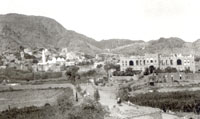
Ahmed Al-Absi: A Yemeni photography master [Archives:2006/960/Culture]
July 3 2006
 |
 |
 |
Ahmed Omar Al-Absi was born in a village in central Yemen in 1911, according to his son Mohammed Ahmed Omar, a doctor in Dhamar province. His grandmother used to retell the story of her son to her grandson. Mohammed still remembers his grandmother describing the story of Al-Absi and his fascination with the camera.
“As a child, he used to hear grownups mention a machine that could marvelously depict people's faces and bodies when they stood in front of it,” she recounted. “He became obsessed with it. When he became a teenager, he went to British-colonized Aden, hell-bent on seeing the machine that could exactly reproduce faces in pictures and on paper.”
Al-Absi began searching for the machine in Aden where he met an Indian of Persian origin who was a photographer and owned a studio. He became his disciple and picked up skills from the photographer, as he kept observing what he was doing in terms of taking and developing photos. He was keen not to neglect any part of the man's practice.
Spending considerable time with the Indian photographer, Al-Absi became a professional in the art of photography. He then thought of returning to his native province of Taiz and introducing that first marvelous machine – the camera – to former North Yemen.
People had heard about it, but few believed it. Aden was an isolated British colony that no one could enter easily, aside from the fact that traveling at that time was difficult and tiresome. Not many Yemenis could afford to pay the travel expenses to Aden; therefore, the majority used donkeys and mules as means of transportation and less frequently by automobiles, which were very few.
Despite difficult circumstances, Al-Absi continued to practice his beloved profession in the city of Taiz. He encountered many hurdles such as the alleged illegality of photography which some muftis say is against Islam. However, Al-Absi wasn't practicing the profession to earn his living but rather spontaneously and instinctively.
With his camera, he wanted to record Yemeni events which thereafter continued to conjure up sad but important memories. Had it not been for Al-Absi, Yemenis couldn't have acquainted themselves with atrocities perpetrated against Yemeni revolutionists by the imam and his henchmen. With his lens, he captured the horrible executions of revolutionists in a square in the city of Taiz, both those of the 1948 and 1955 revolutions.
Of those revolutionists whose executions were memorialized on film by Al-Absi's still camera were judge Al-Sayiaghi and Al-Luqayiah. Through his lens, he depicted the horrible sword of Al-Woshah, the imam's executioner, beheading revolutionists. Even the moment of executing Al-Woshah himself, the imam's faithful henchman, was attended by Al-Absi's camera.
It was not only executions that were recorded by the lens of this creative and spontaneous artist. Al-Absi also shot numerous scenes from the miserable life of Yemenis at that time and their villages, as well as public places and the remarkable landmarks in Taiz and Aden.
Abdul-Rahman Bajjash, deputy Editor-in-Chief of Al-Thawra daily, said practically every real photographer in Yemen and every studio in any Yemeni city have something to do with this great photographer, who was a pioneer and a master in the art of photography. Al-Absi sensed his responsibility toward his nation and his people and carried it regularly and constantly without reluctance. He taught all those wanting to learn photography and master its nuances. Not only that, he also helped those who wanted to learn but had little sustenance.
Al-Absi's son Mohammed displayed a great quantity of pictures his father shot. Each photo retells a thousand tales and stories, reviving memories and enlivening scenes from Yemeni villages and people in the past. The collection is a registry that surpasses organized corporate efforts.
While showing the collection, Al-Absi's son voiced his wish to see his father's works cared for by the state or any organization by publishing a book displaying and preserving such an invaluable heritage.
——
[archive-e:960-v:14-y:2006-d:2006-07-03-p:culture]


